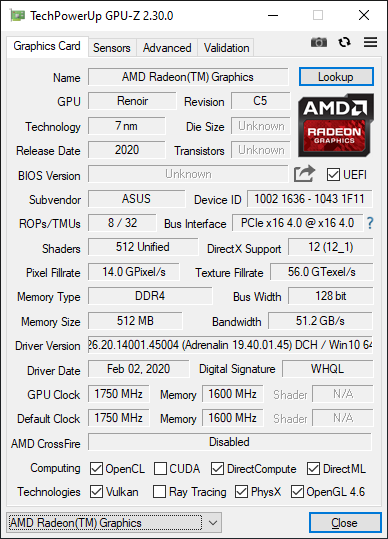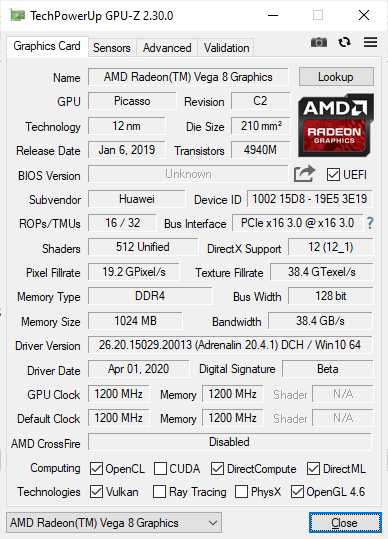AMD’s Mobile Revival: Redefining the Notebook Business with the Ryzen 9 4900HS (A Review)
by Dr. Ian Cutress on April 9, 2020 9:00 AM ESTTesting the Ryzen 9 4900HS Integrated Graphics
Under the hood of the Ryzen 9 4900HS, aside from the eight Zen 2 cores, is an enhanced Vega 8 graphics solution. For this generation of mobile processors, AMD is keeping the top number of compute units to 8, whereas in the previous generation it went up to Vega 11. Just by the name, one would assume that AMD has lowered the performance of the integrated graphics. This is not the case.
For the new Ryzen Mobile 4000 processors, the Vega graphics here are enhanced in three main ways over the previous generation. First is that it is built on the 7nm process node, and AMD put a lot of effort into physical design, allowing for a more optimized version that has a wider voltage/frequency window compared to the previous generation. Secondly, and somewhat connected, is the frequency: the new processors top out at 1750 MHz, rather than 1400 MHz, which would naturally give a simple 25 % boost with all other things being equal. Third on the list is memory, as the new platform supports up to DDR4-3200, rather than DDR4-2400, providing an immediate bandwidth boost which is what integrated graphics loves. There’s also the nature of the CPU cores themselves, having larger L3 caches, which often improves integrated graphics workloads that interact a lot with the CPU.
Normally, with the ASUS Zephryus G14, the switching between the integrated graphics and the discrete graphics should be automatic. There is a setting in the NVIDIA Control Panel to let the system auto-switch between integrated and discrete, and we would expect the system to be on the IGP when off the wall power, but on the discrete card when gaming (note, we had issues in our battery life test where the discrete card was on, but ASUS couldn’t reproduce the issue). In order to force the integrated graphics for our testing, because the NVIDIA Control Panel didn’t seem to catch all of our tests to force them onto the integrated graphics, we went into the device manager and actually disabled the NVIDIA graphics.
This left us with AMD’s best integrated graphics in its Ryzen Mobile 4000 series: 1750 MHz of enhanced Vega 8 running at DDR4-3200.

Renoir with Vega 8 – updated to 20.4 after this screenshot was taken
Our comparison point here is actually a fairly tricky one to set up. Unfortunately we do not have a Ryzen 7 3750H from the previous generation for comparison, but we do have an Honor Magicbook 14, which has a Ryzen 5 3500U.
This is a 15 W processor, running at 1200 MHz and DDR4-2400, which again makes the comparison a little tricky, but it is better than comparing it to the Intel HD630 graphics in the Razer Blade.
We also re-ran the benchmarks on the latest drivers with AMD's 65 Desktop APUs, the Ryzen 5 3400G (with Vega11) and the Ryzen 3 3200G (with Vega 8). These are running at DDR4-2933, the AMD maximum officially supported by these APUs (which means anything above this is overclocking).


This is a pretty substantial difference, no joke.



Hopefully we will get more variants of the Ryzen integrated graphics to test, along with an Ice Lake system.











267 Comments
View All Comments
Tams80 - Thursday, April 9, 2020 - link
It's still not as handy as having a webcam just there, at a decent height and angle with no stands/tripods, etc. to worry about. And of course no Windows Hello.RollingCamel - Thursday, April 9, 2020 - link
That's for sure.Hardware Geek - Friday, April 10, 2020 - link
I'm with you on the webcam. I've done the exact same thing and never used mine. The first think I do is put tape over it. No webcam is a plus for me personally.Namisecond - Monday, April 13, 2020 - link
Dogma meets reality.I had the same moment, when I bought my last laptop. I thought I needed massive computing power and the ability to game triple-A titles on the go. But then I remembered how I actually used my computer. A lot of note-taking, media consumption, web-browsing. For all the times I actually had to do any "heavy lifting" on the laptop, It was more likely I'd save it for when I got to a desktop or workstation with a big screen. What does this have to do with web cams? I've never had to use the ones that came with my laptops, but I see others who do. I'd like for my laptop to have the capability, but rationally speaking, I don't need it. It shouldn't be a deal-breaker for me.
R3MF - Thursday, April 9, 2020 - link
Would love to see a cheaper model with:No dGPU
R9 4900H
16GB+512GB
1080p 120hz screen
same battery
joaolx - Thursday, April 9, 2020 - link
Would also love for something similar although not necessarily this model. I have no need for one on a laptop but would love to have one of these new chips . My dream machine right now would be:No dGPU
Any of the 8 Core/16 thread options - 4900H/HS or 4800H/HS or 4800U
32GB + 1TB
Any decent 1080p or higher display really, indifferent on higher refresh
Similar battery life - if even better with the 4800U it'd be my choice
twotwotwo - Thursday, April 9, 2020 - link
Speculation, but sounds likely you'll get exactly what you're asking for when the 4800U-based thin-and-lights come out.R3MF - Thursday, April 9, 2020 - link
If they're set to 25w with cooling to match then yes.neblogai - Thursday, April 9, 2020 - link
~same for me: H(/HS), 16GB of LPDDR4, in a 13-14" ultraportable with bright screen.mocseg - Friday, April 10, 2020 - link
Lenovo Yoga slim.